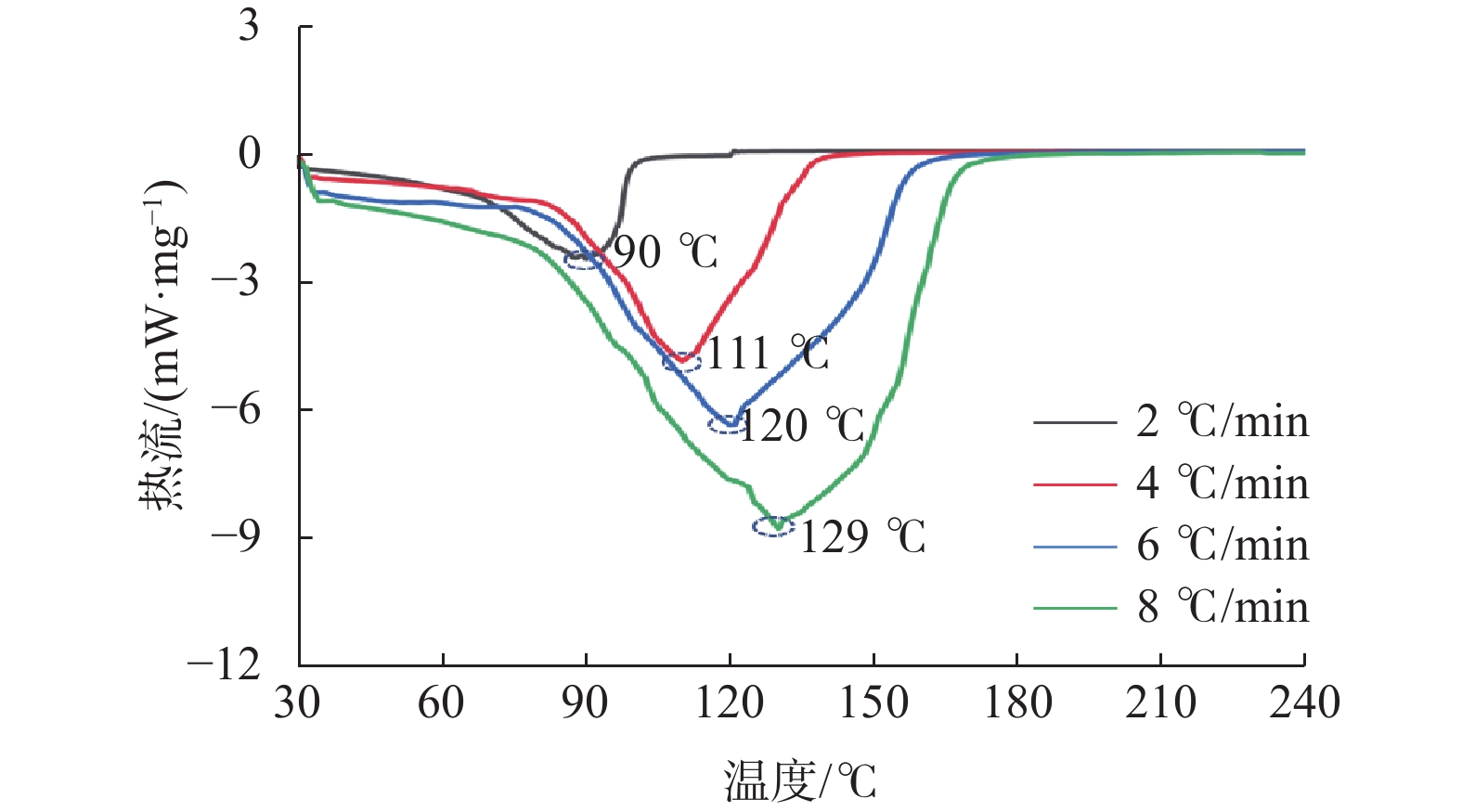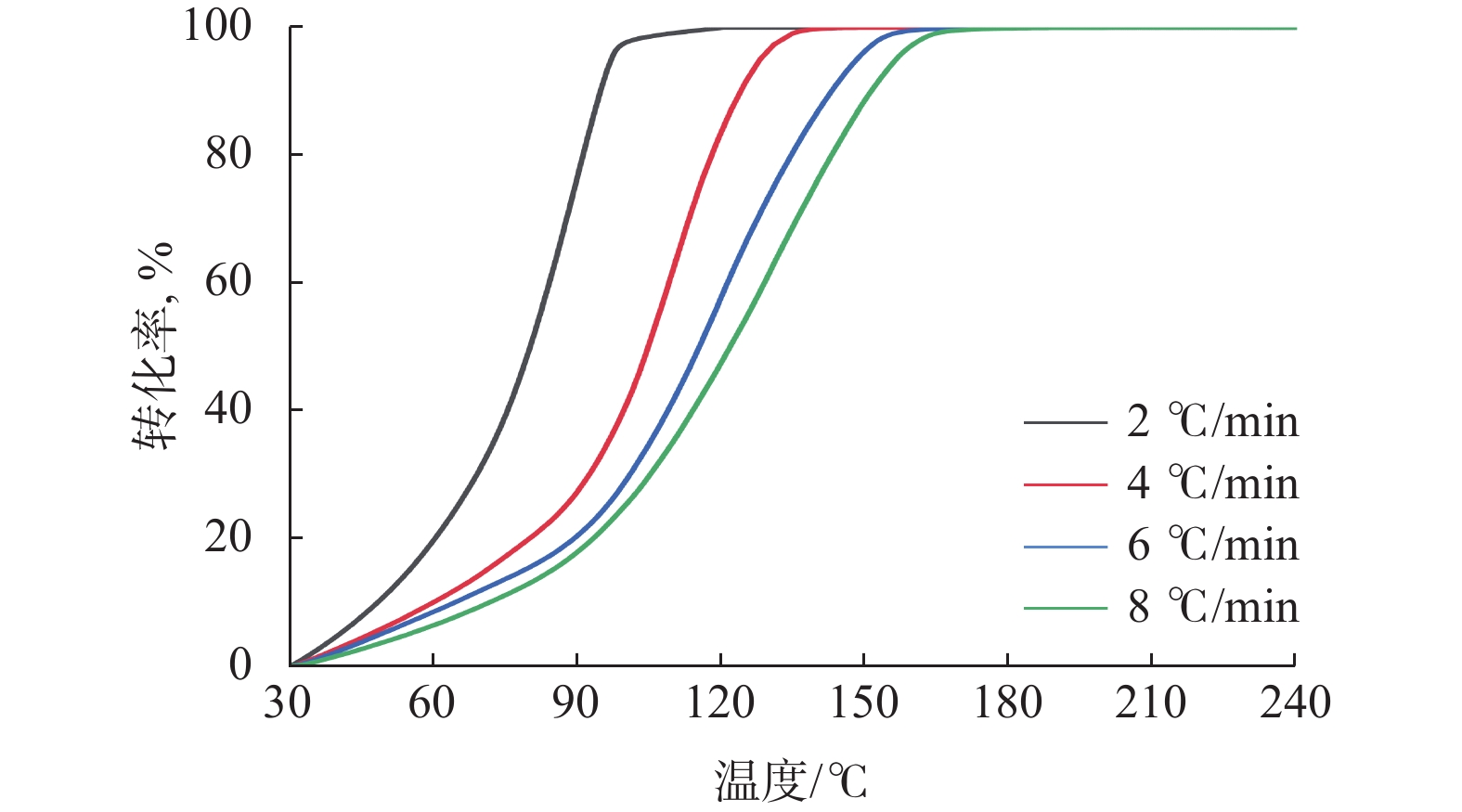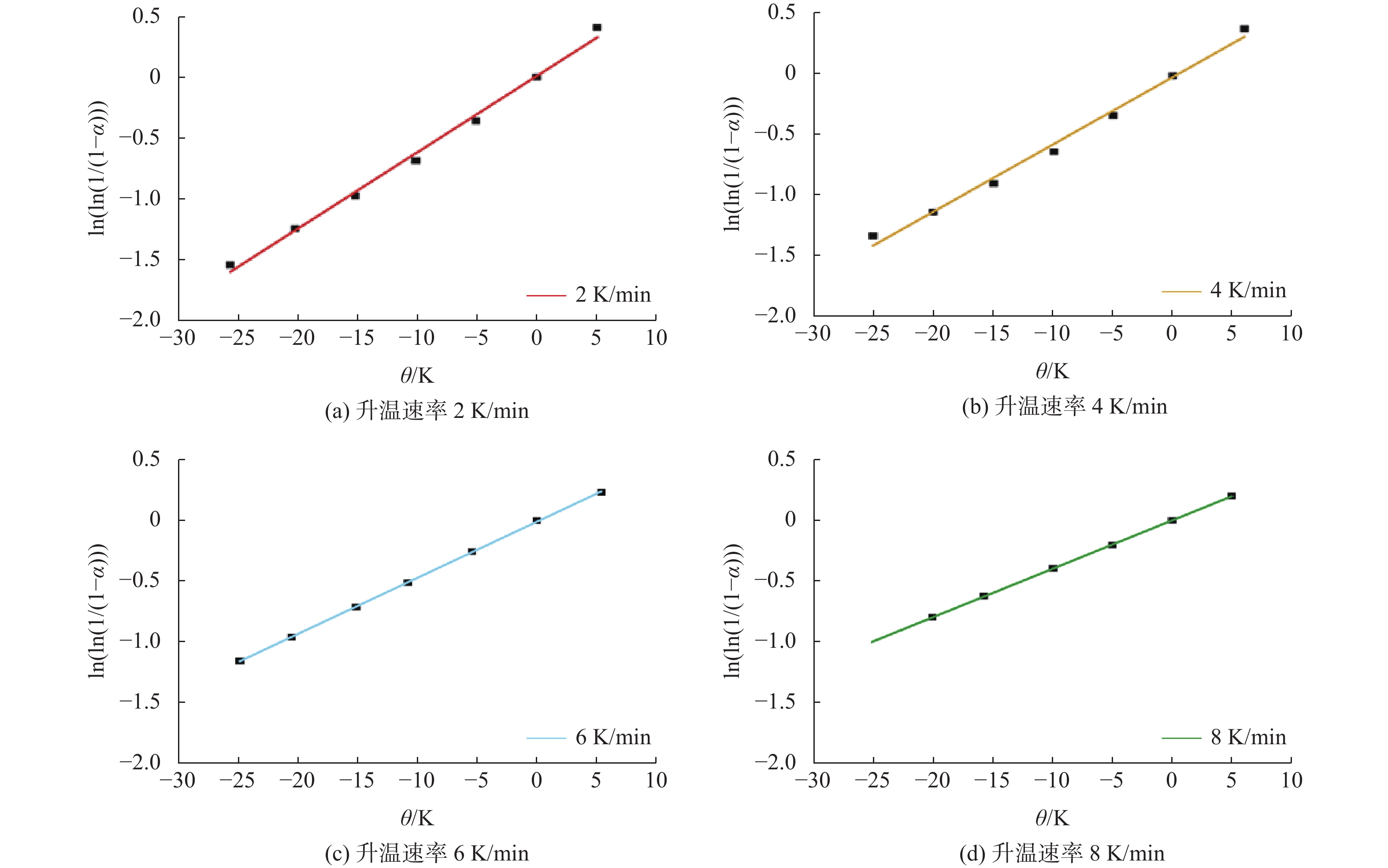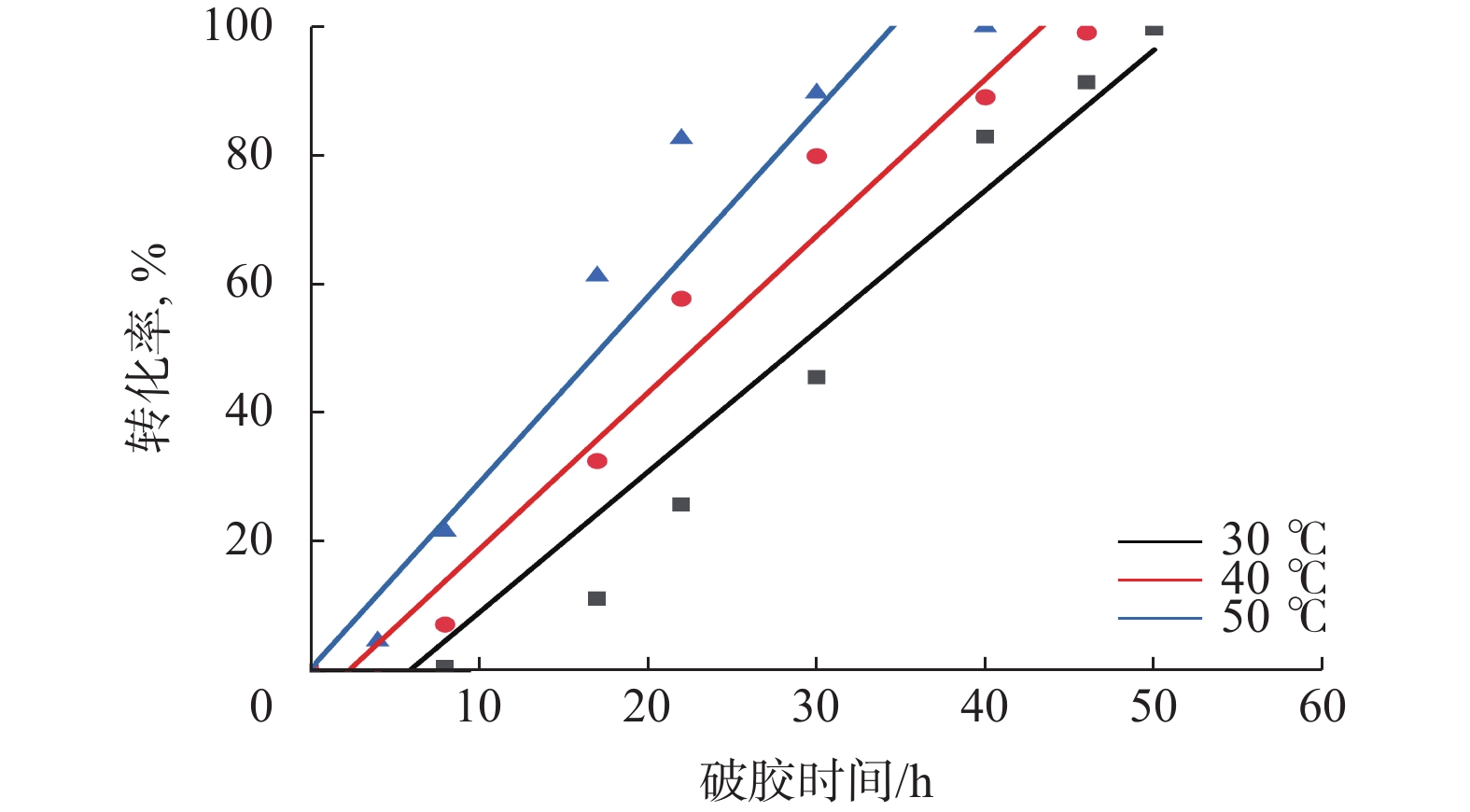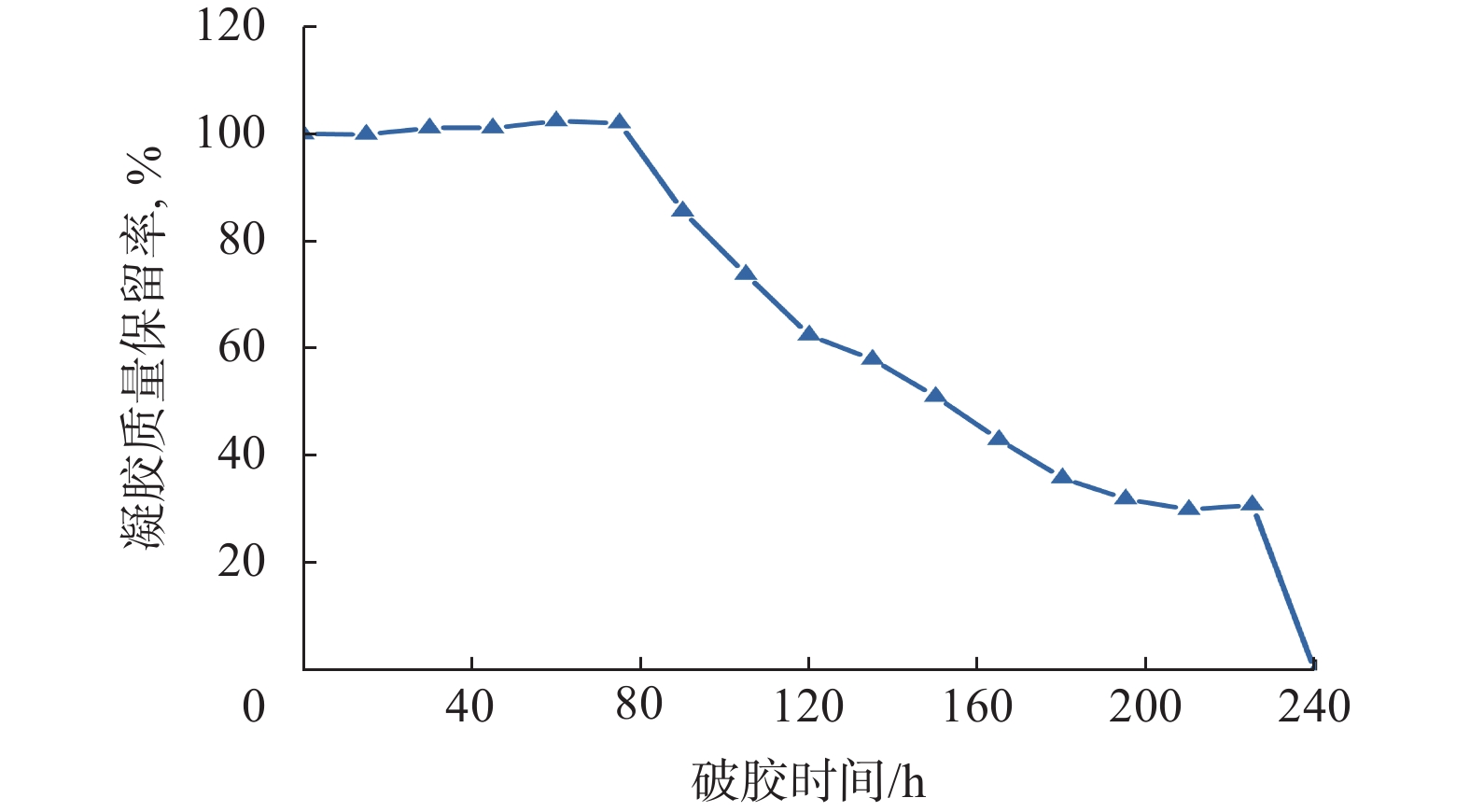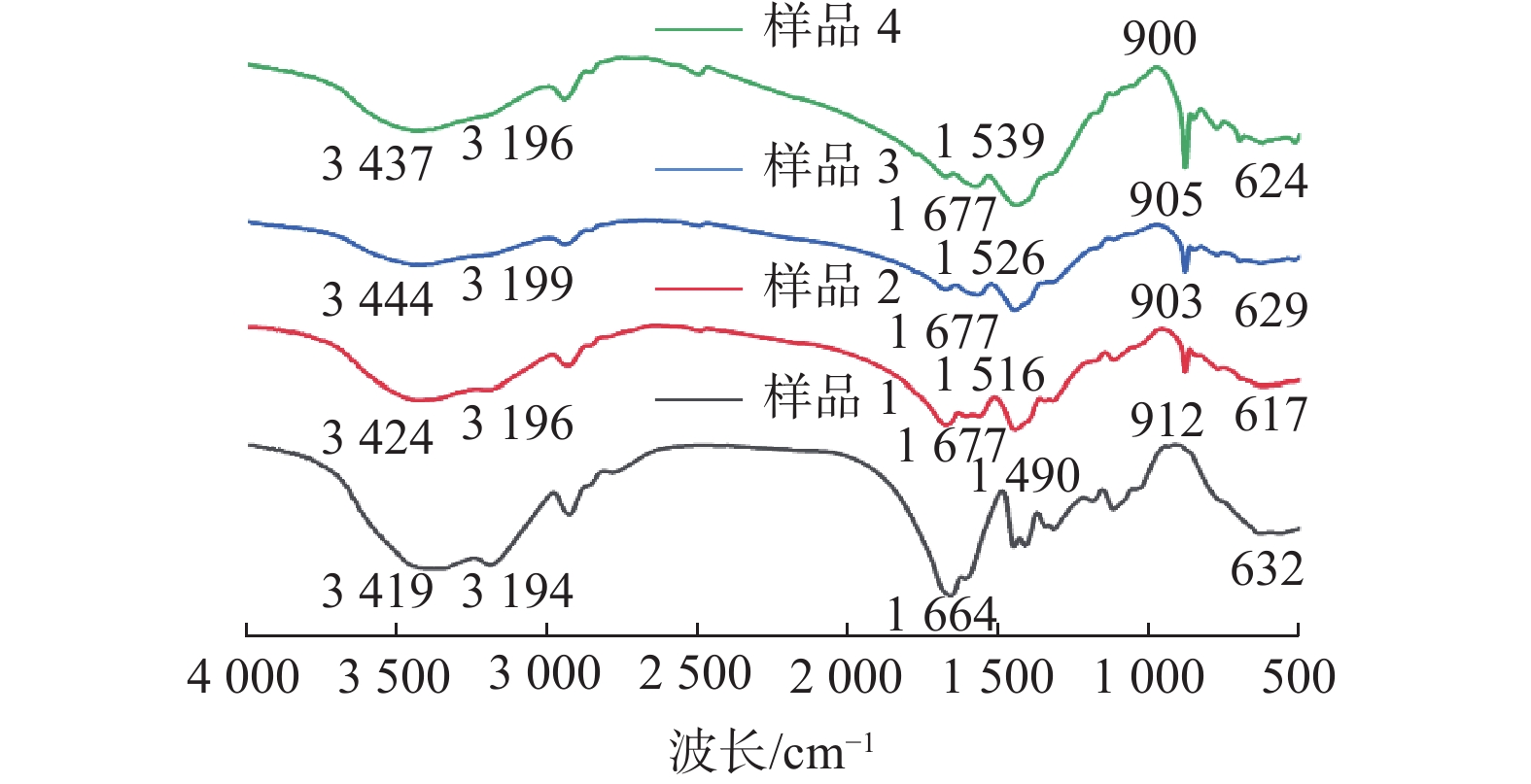Degradation kinetics of ultra-high strength gel with oxidative gel breakage
-
摘要:
为明确单体聚合类凝胶在暂堵作业结束后的氧化破胶降解机理,开展了凝胶氧化破胶降解动力学研究。运用Horowitz-Metzger、Coats-Redfern和Flynn-Wall-Ozawa模型,计算得到超高强度凝胶(USGel)降解动力学参数,对比分析得到适合USGel的降解动力学模型;结合扫描电镜、傅里叶红外光谱分析等实验,揭示了破胶剂破碎降解USGel的机理,并得到低、中、高温修正后的降解预测模型。研究结果表明,该模型适用于预测USGel中高温降解时间;根据凝胶降解机理,破胶剂逐步消耗USGel酰胺基团的氨基(—NH2)和羧酸基团的羟基(—OH)等化学键,聚合物分子链逐步断裂,最终USGel破碎变成液体。研究结果为改进油气井暂堵破胶技术提供了理论依据。
Abstract:(Aim) In order to clarify the mechanism of oxidative gel degradation of monomer-polymerised gels at the end of temporary plugging operations, a kinetic study on the oxidative gel degradation of gels was carried out. (Methods) Using the Horowitz-Metzger, Coats-Redfern and Flynn-Wall-Ozawa models, the degradation kinetic parameters of ultra-high-strength gel (USGel) were calculated, and the degradation kinetic model suitable for USGel was obtained by comparative analysis; combining with the scanning electron microscope, Fourier infrared spectroscopy analysis and other experiments, the mechanism of the degradation of USGel by breaking of gel breakers was revealed, were obtained by using Semenov's equation to obtain the modified degradation prediction model for low, medium, and high temperatures, which was suitable for predicting the time of degradation at medium and high temperatures of USGel by analysing the experimental data; and the degradation mechanism was clarified, the The gel-breaker gradually consumes the chemical bonds such as amino group (-NH2) and hydroxyl group (-OH) of amide group and carboxylic acid group in USGel, and the polymer molecular chain is gradually broken, and finally USGel is broken into liquid. (Conclusion) The results of the study provide a theoretical basis for the improvement of the temporary plugging and breaking technology of oil and gas wells.
-
Keywords:
- degradation kinetics /
- degradation prediction /
- degradation mechanism /
- oxidative gel-breaking /
- gel
-
-
表 1 Horowitz-Metzger模型降解动力学参数
Table 1 Degradation kinetics parameters of Horowitz-Metzger model
β/(K·min−1) E/(kJ·mol−1) TS/K 斜率 截距 lnA 决定系数 2 66.696 358.41 0.062 45 0.005 68 20.31 0.994 4 67.288 383.15 0.055 13 -0.035 40 19.69 0.992 6 60.021 396.33 0.045 93 -0.009 04 16.92 0.999 8 53.871 404.15 0.039 67 -0.003 04 14.82 0.999 表 2 Coats-Redfern模型降解动力学参数
Table 2 Degradation kinetics parameters of Coats-Redfern model
β/(K·min−1) E/(kJ·mol−1) n 斜率 截距 lnA 决定系数 2 54.882 1 −6 601.19 6.652 16.26 0.995 4 25.031 1 −3 010.73 −5.122 4.66 0.972 6 23.954 1 −2 881.14 −6.05 4.13 0.973 8 21.210 1 −2 551.08 −7.428 2.87 0.952 表 3 Flynn-Wall-Ozawa模型降解动力学参数
Table 3 Degradation kinetics parameters of Flynn-Wall-Ozawa model
α,% E/(kJ·mol−1) 斜率 截距 lnA 决定系数 10 24.22 −2 912.62 9.36 6.58 0.988 20 17.63 −2 120.00 6.64 5.21 0.977 30 17.14 −2 061.44 6.30 5.18 0.961 40 16.80 −2 020.85 6.08 5.14 0.968 50 16.26 −1 955.15 5.82 5.11 0.982 60 15.79 −1 899.18 5.60 5.05 0.992 70 15.06 −1 811.72 5.31 5.01 0.996 80 14.34 −1 724.87 5.02 4.96 0.994 90 13.47 −1 620.38 4.69 4.97 0.994 -
[1] 葛罗. 大庆油田萨北区块中渗透砂岩油藏凝胶调剖剂运移吸附试验研究[J]. 石油钻探技术,2023,51(3):119–125. doi: 10.11911/syztjs.2023063 GE Luo. Experimental study on the migration and adsorption of gel profile control agent in medium-permeability sandstone in the Sabei block of Daqing Oilfield[J]. Petroleum Drilling Techniques, 2023, 51(3): 119–125. doi: 10.11911/syztjs.2023063
[2] 于海山,王剑,吴错. 大庆外围油田葡萄花油层水平井压裂技术进展[J]. 油气藏评价与开发,2013,3(2):51–56. doi: 10.3969/j.issn.2095-1426.2013.02.011 YU Haishan, WANG Jian, WU Cuo. Horizontal well fracturing technology progress of Putaohua reservoir in Daqing peripheral oilfields[J]. Petroleum Reservoir Evaluation and Development, 2013, 3(2): 51–56. doi: 10.3969/j.issn.2095-1426.2013.02.011
[3] 彭芬,张宝,杨鹏程,等. 库车山前超深巨厚致密砂岩纵向细分层改造技术[J]. 石油钻探技术,2024,52(2):187–193. doi: 10.11911/syztjs.2023113 PENG Fen, ZHANG Bao, YANG Pengcheng, et al. Vertical subdivision layer stimulation technology for ultra-deep and super-thick tight sandstone in Kuqa Piedmont[J]. Petroleum Drilling Techniques, 2024, 52(2): 187–193. doi: 10.11911/syztjs.2023113
[4] 李亮,方俊伟,彭博一,等. 塔河油田碳酸盐岩储层中聚合物凝胶堵漏技术[J]. 钻井液与完井液,2024,41(4):437–443. doi: 10.12358/j.issn.1001-5620.2024.04.003 LI Liang, FANG Junwei, PENG Boyi, et al. Control mud losses into carbonate reservoirs with polymer gels in Tahe Oilfield[J]. Drilling Fluid & Completion Fluid, 2024, 41(4): 437–443. doi: 10.12358/j.issn.1001-5620.2024.04.003
[5] 赵明伟,戴彩丽,刘棚,等. 压驱一体化双子表面活性剂滑溜水特性及高效渗吸排驱机制[J]. 石油学报,2024,45(9):1409–1421. ZHAO Mingwei, DAI Caili, LIU Peng, et al. Characteristics and efficient imbibition-oil displacement mechanism of Gemini surfactant slickwater for integrated fracturing flooding technology[J]. Acta Petrolei Sinica, 2024, 45(9): 1409–1421.
[6] 刘一唯,王健,张德平,等. 用于CCUS油藏压井的环境响应型暂堵剂研制与应用[J]. 断块油气田,2024,31(2):357–362. LIU Yiwei, WANG Jian, ZHANG Deping, et al. Development and application of the environmental response temporary plugging agent for well killing of CCUS oil reservoir[J]. Fault-Block Oil & Gas Field, 2024, 31(2): 357–362.
[7] 李昭滢,杨旭,杨杰,等. 压裂液稠化剂两性聚丙烯酰胺的合成与性能评价[J]. 石油钻探技术,2023,51(2):109–115. doi: 10.11911/syztjs.2023044 LI Zhaoying, YANG Xu, YANG Jie, et al. Synthesis and property evaluation of an amphoteric polymer fracturing fluid thickener[J]. Petroleum Drilling Techniques, 2023, 51(2): 109–115. doi: 10.11911/syztjs.2023044
[8] JIA Hu, YANG Xinyu, LI Sanxi, et al. Nanocomposite gel of high-strength and degradability for temporary plugging in ultralow-pressure fracture reservoirs[J]. Colloids and Surfaces A: Physicochemical and Engineering Aspects, 2020, 585: 124108. doi: 10.1016/j.colsurfa.2019.124108
[9] 汪万飞,付红. 高压注水井带压作业凝胶封堵体系性能评价[J]. 油田化学,2023,40(4):621–626. WANG Wanfei, FU Hong. Performance evaluation of gel plugging system for high pressure water injection well under pressure operation[J]. Oilfield Chemistry, 2023, 40(4): 621–626.
[10] JIA Hu, KANG Zheng, LI Zhijie, et al. The potential of ultrahigh strength gel through novel multistage reinforcement method for sealing operations in medium to ultralow temperature reservoirs[J]. SPE Journal, 2022, 27(4): 2145–2160. doi: 10.2118/209602-PA
[11] KANG Zheng, JIA Hu, LI Zhongguo, et al. Comprehensive evaluation of chemical breakers for multistage network ultra-high strength gel[J]. Petroleum Science, 2023, 20(5): 2864–2878. doi: 10.1016/j.petsci.2023.05.001
[12] KARIMPOUR-MOTLAGH N, KHONAKDAR H A, JAFARI S M A, et al. Influence of polypropylene and nanoclay on thermal and thermo-oxidative degradation of poly(lactide acid): TG-FTIR, TG-DSC studies and kinetic analysis[J]. Thermochimica Acta, 2020, 691: 178709. doi: 10.1016/j.tca.2020.178709
[13] 宋高杰,吴正环,王权,等. 二维纳米FGP/h-BN协同阻燃EP复合材料的热降解动力学[J]. 塑料工业,2025,53(1):119–126. doi: 10.3969/j.issn.1005-5770.2025.01.018 SONG Gaojie, WU Zhenghuan, WANG Quan, et al. Thermal degradation kinetics of two-dimensional nano FGP/h-BN synergistic flame-retardant EP composites[J]. China Plastics Industry, 2025, 53(1): 119–126. doi: 10.3969/j.issn.1005-5770.2025.01.018
[14] 杨帆,叶子玮,陈楠纬,等. A型分子筛对WPCBs燃烧特性的影响[J]. 环境工程,2021,39(8):156–164. YANG Fan, YE Ziwei, CHEN Nanwei, et al. Effects of a zeolite on pyrolysis characteristics of waste printed circuit boards[J]. Environmental Engineering, 2021, 39(8): 156–164.
[15] 李福来,杨增福,陈亚芹,等. 快速拉挤用环氧树脂固化动力学及动态力学性能研究[J]. 中国塑料,2023,37(6):66–73. LI Fulai, YANG Zengfu, CHEN Yaqin, et al. Study on curing kinetics and dynamic mechanical properties of epoxy resin for rapid pultrusion[J]. China Plastics, 2023, 37(6): 66–73.
[16] 何芬芬,林庆文,刘玲,等. 升温速率对油漆稀料和塑料共热解特性的影响[J]. 消防科学与技术,2021,40(10):1443–1446. HE Fenfen, LIN Qingwen, LIU Ling, et al. Effect of heating rate on the co-pyrolysis characteristics of paint thinners and plastics[J]. Fire Science and Technology, 2021, 40(10): 1443–1446.
[17] KARMARKAR S, SHASHIDHARA G M. Thermal decomposition kinetics of jute fiber filled HDPE composites[J]. Journal of the Indian Academy of Wood Science, 2018, 15(1): 33–40. doi: 10.1007/s13196-018-0205-6
[18] ALTARAWNEH S. Insights into the oxidative thermal stability of mesoporous triazine-based organic polymers: kinetics and thermodynamic parameters[J]. International Journal of Chemical Kinetics, 2024, 56(12): 691–702. doi: 10.1002/kin.21754
[19] AÇIKALIN K. Thermogravimetric analysis of walnut shell as pyrolysis feedstock[J]. Journal of Thermal Analysis and Calorimetry, 2011, 105(1): 145–150. doi: 10.1007/s10973-010-1267-x
[20] 郭子如,杜宝强,高中国,等. 基于热爆炸理论的铵油炸药高温炮孔耐热行为预测[J]. 工程爆破,2022,28(1):107–112. GUO Ziru, DU Baoqiang, GAO Zhongguo, et al. Prediction of heat-resistant behavior of ANFO in high-temperature blast holes based on thermal explosion theory[J]. Engineering Blasting, 2022, 28(1): 107–112.
[21] QIU Liewei, SHEN Yiding, WANG Chen, et al. Scanning electron microscopy analysis of guar gum in the dissolution, gelation and gel-breaking process[J]. Polymer Testing, 2018, 68: 95–99. doi: 10.1016/j.polymertesting.2018.04.001
-
期刊类型引用(4)
1. 沈园园,王在明,朱宽亮,吴艳. 溶胶-凝胶法制备核壳结构的延迟破胶剂. 钻井液与完井液. 2020(01): 121-126 .  百度学术
百度学术
2. 巩锦程,王彦玲,罗明良,李强,汤龙皓,梁雷. 交联酸压裂液体系研究进展及展望. 应用化工. 2020(08): 2058-2062 .  百度学术
百度学术
3. 王丽伟,石阳,高莹,韩秀玲,王燕. 我国油气藏增产酸液体系的发展历程及进展. 河南化工. 2019(07): 3-6 .  百度学术
百度学术
4. 鲁晓华,程立,廖锐全,张慢来,李振. 新型冻胶封隔材料的制备及性能. 油田化学. 2017(04): 576-580+609 .  百度学术
百度学术
其他类型引用(6)



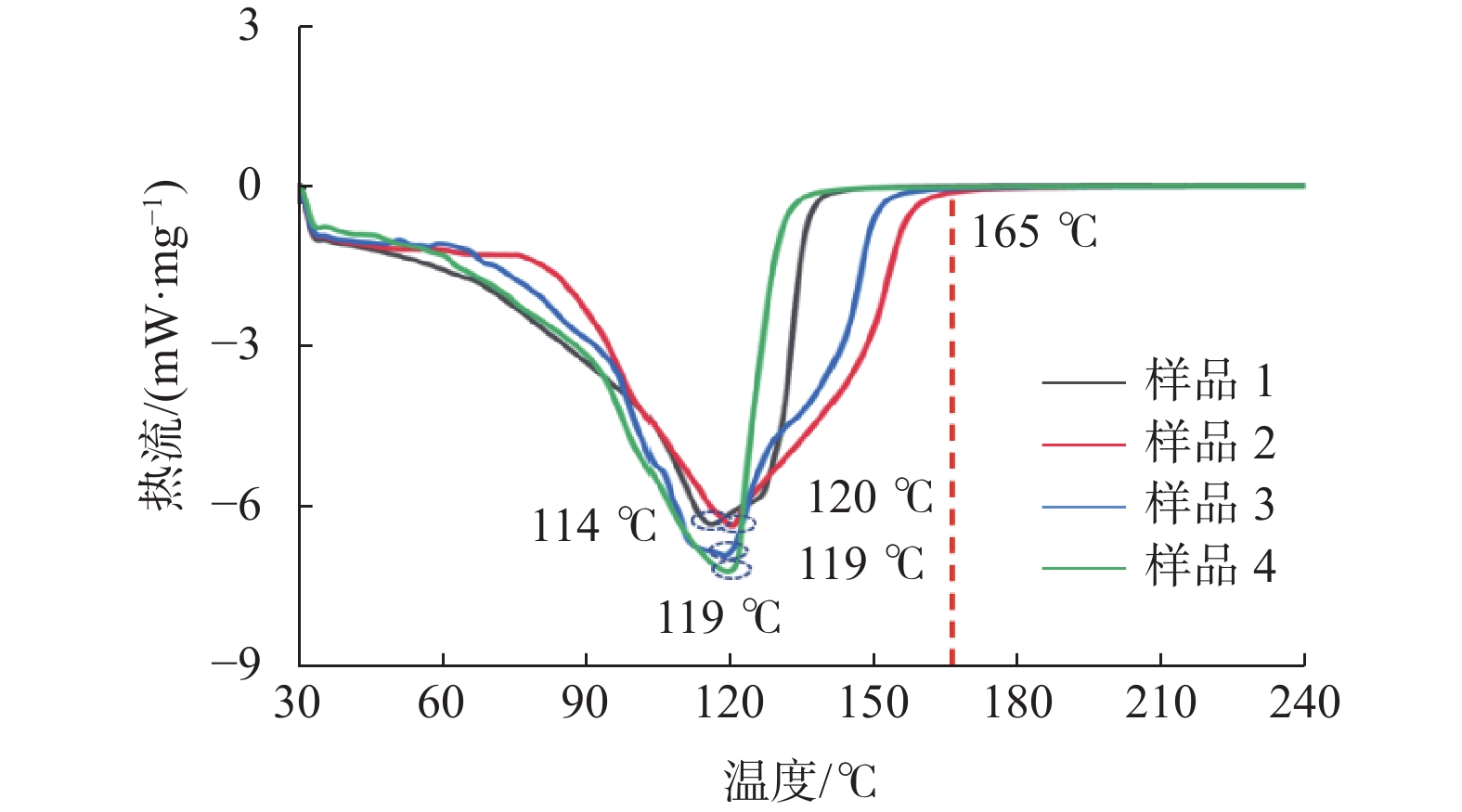
 下载:
下载:

